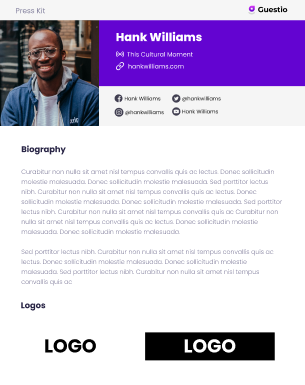Table of Contents
How to Get Booked On Podcasts
Defining Your Goal
What do you want to achieve from appearing on podcasts? You can't devise a strategy without a sense of knowing what you want to accomplish.
Promotional But Not Direct Response
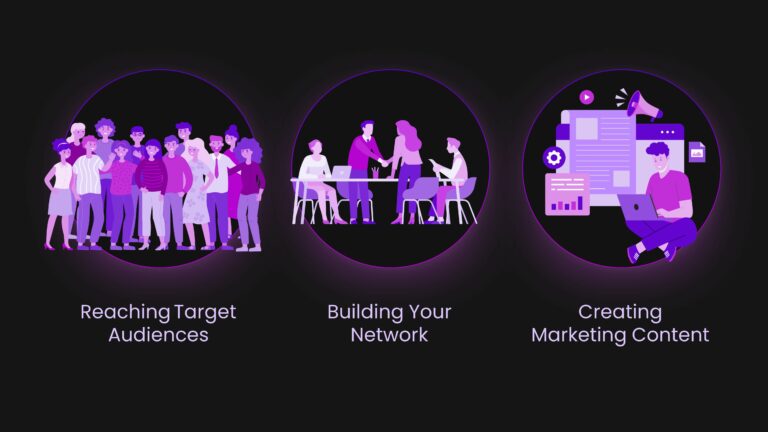
Podcast guesting is a promotional channel, but it's not direct response marketing. You will not see attributed web traffic. You’re unlikely to see leads or sales from a few podcast appearances.
Podcast tours build brand awareness. Brand awareness can lead to leads and sales, but only if that awareness reaches the right people.
A good goal for a podcast guest campaign is to expand your reach. Campaigns can expand your reach through the audience listenership of a given episode, through building your network (i.e. conversations with podcast hosts in your industry), and through the content creation and promotion that comes with an appearance.
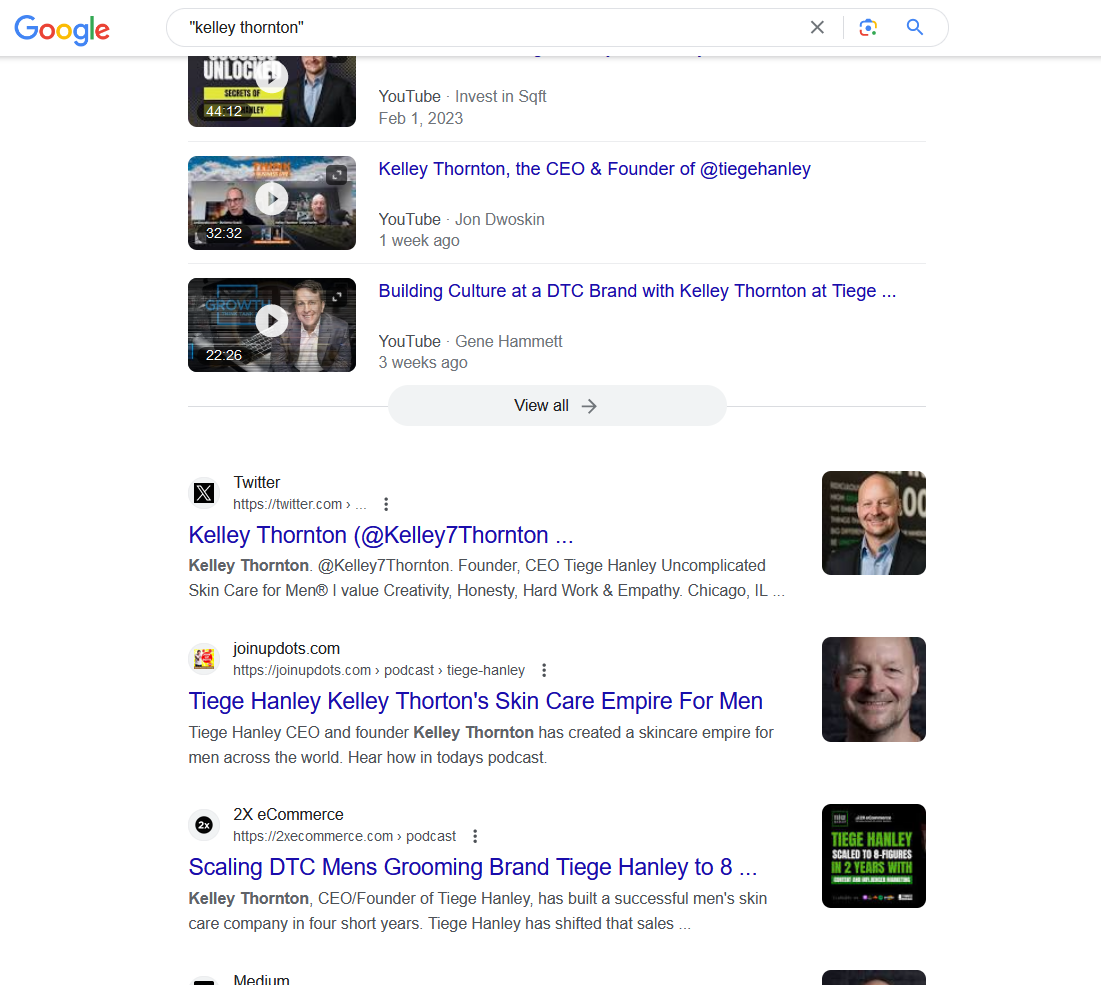
Just a few podcast appearances can produce some impressive
search engine results and create credibility.
On Sales & Attribution
Podcast guesting can drive sales, but there is no reliable marketing attribution in podcast appearances. Unless you appear on podcasts over time and control for all other marketing variables (changes in other channels, messaging, etc), it will be hard to attribute sales to your appearances.
Our clients who have successfully boosted sales and attributed it to their appearances have appeared on dozens or hundreds of podcasts over many months of effort.
The best way to attribute sales is to bring a dedicated landing page URL (or domain name) and an offer that’s tightly aligned with the topic(s) of conversation of the appearance. While most guests ask listeners to follow them on social media, we suggest that if attribution is your goal, you’ll want a conversion action on a dedicated landing page that brings value to listeners. That offer might be a lead magnet, application or call booking page.
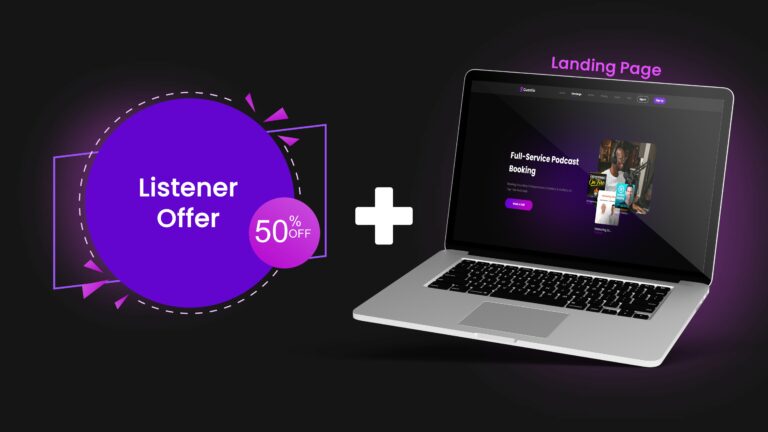
We always recommend asking "where did you find us?" or “how did you hear about us?” on whatever conversion action you have on your personal and company websites to track attribution of less attributable marketing channels.
Podcast Tours Are Inexpensive
Podcast guesting is not a "low cost" marketing strategy. Appearing on podcasts is a lot of work from expensive talent. So, while podcast guesting might appear to be “cheap,” it's time and energy consuming and doesn’t have direct attribution.
Yet, it's also a channel with the highest upside for serendipitous results. Why serendipity?
- Brand association - between you/yours and podcast hosts
- Audience know/like/trust - in a way that ads or written content can't replicate
- Networking - value from meeting & talking with powerful podcasters
- SEO via Backlinks - from published episodes on high Domain Authority websites
It's important to note that results from appearances aren't fast, either. You can secure "Yes's" from a few podcast hosts relatively quickly, but for many busy podcasters, appearances can be booked 2-12 weeks out. Interviews might get published 2-12 weeks after that. Can you wait 24 weeks to get content published?

Listenership & Audience
Many podcast tours are built around reaching a certain number of listeners. Some are built around networking with a set of podcast hosts in a given industry. Others are tailored toward the remixed, cut and spliced content produced from specific appearances on shows. Often, people's goals are mixed. Just associating with an authoritative or influential podcast host can place authority on you in the mind of your target audience. That's what makes podcast guesting such a uniquely powerful channel for building know, like, and trust in an audience.
Lots of people want to be on popular shows that they've heard of and think they'll generate business by associating with a famous podcaster and speaking to their audience. This is often true, but you're probably not going to get on any of the interviews in the Top 50 Most Listened to Podcasts, and how much of those audiences is appropriate for what you sell?
Start with clarity on the audience you want to reach and how far you want to extend that reach.
What We Recommend
There are two ways to execute podcast guesting - either as a short-term campaign or a long-term, sustainable program.
Campaigns
A podcast guesting campaign or "podcast tour" is used to promote a specific launch, like a brand, product, book or event. These high velocity campaigns last for a set amount of time - usually 3-6 months, and often involve appearances on several podcasts per week.

Campaigns often require travel for in-person appearances. Promotional campaigns require a lot of scheduling, organization, and prep work to pull off. Some campaigns involve appearances on 10 high-impact shows but most land between 20-50.
John Lee Dumas once appeared on 300 podcasts over a 90-day period, an exceptional volume of appearances.
Campaign Features:
- Projects for 3-6 months
- ~Daily podcast appearances
- Coordinating schedules, including release dates and promotion windows
Programs
A podcast guesting program is an ongoing method of promoting a personal or business brand. Generally, these programs are part of an ongoing marketing/PR effort to expand a brand's reach and influence a target market over time.
Growth of ClickUp along with consistent podcast appearances (via Guestio Concierge) led Zeb Evans to larger PR opportunities, including a cover and feature in Foundr Magazine.

Many C-suite executives aim to appear on one podcast per week, or a few per month to promote their companies and humanize their personal brands.
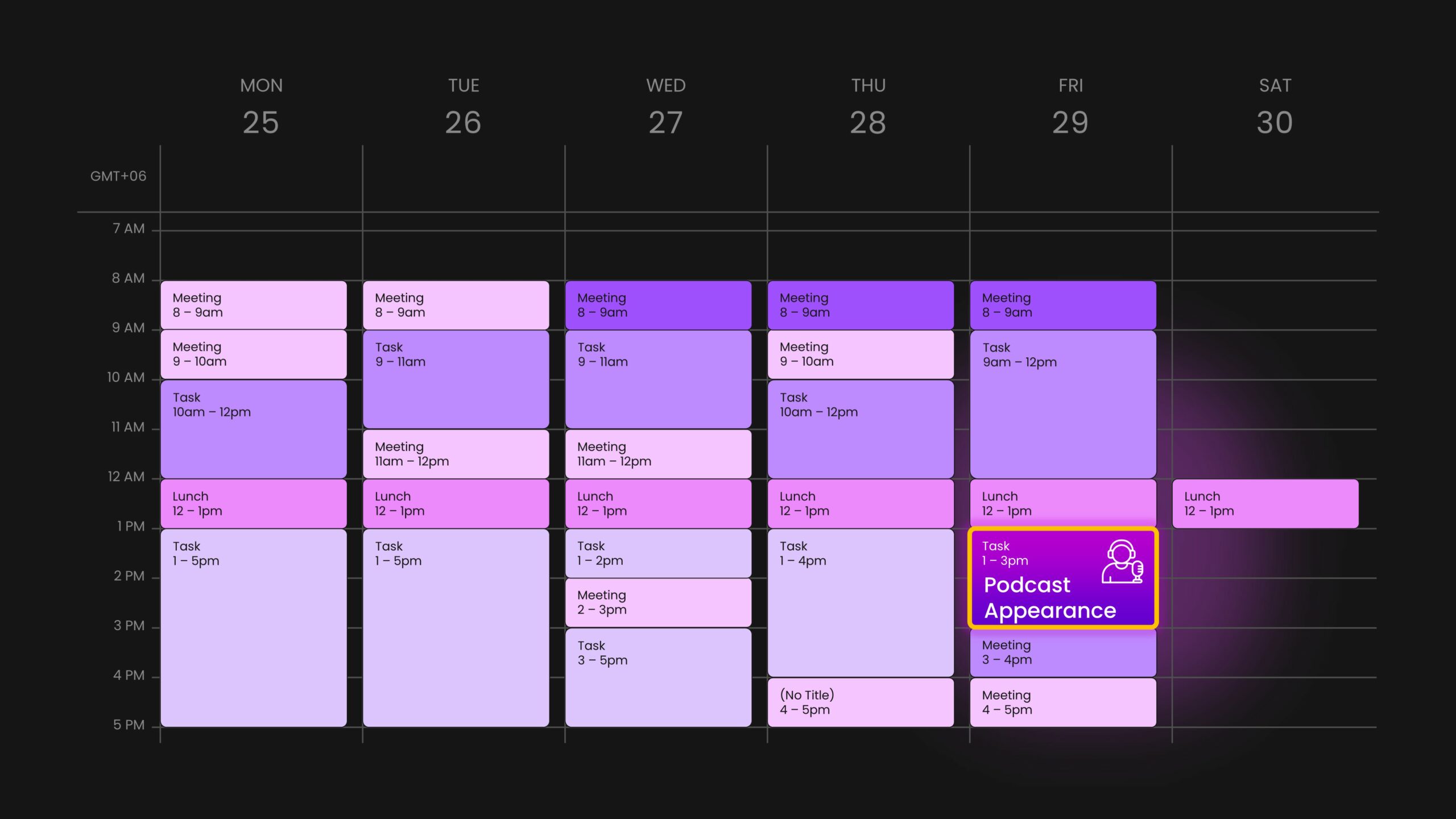
Program Features:
- Ongoing effort to appear on shows
- ~ Weekly podcast appearances
- Grows reach and brand affinity
Creating Your Strategy
Four Elements of Strategy
There are four elements to designing a strategy for podcast appearances: Topics, Size, Speed, and Volume.
A podcast guesting strategy requires that you know what types of shows you want to appear on, the size of audiences you want to engage, how quickly you want to knock out appearances, and how many shows you want to appear on.
Topics
Topics are what a given podcast is about and what its episodes cover. No podcast directories use the term "topics," but all are organized into Categories. You can see Apple's categories here. Sorting through specific categories can help you narrow down a list of potential podcasts to appear on, but with only six Business Categories, Categories is just a starting point for finding the types of shows you want to be on.
From a Topic perspective, "Entrepreneurship" Topic might be "fundraising" or "growth marketing." For a growth marketing guest who targets entrepreneurs, the "Entrepreneurship" category is a great starting point.
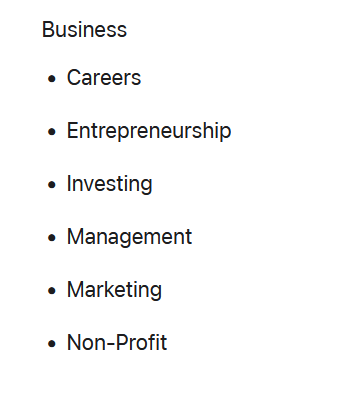
Size
The size of a podcast’s audience is important for maximizing the value of your appearances. Knowing roughly how many listeners or downloads per episode that a given podcast has tells you the expected size of audience of a potential appearance.
"Size" is an inexact science, but estimates from various databases will help you land in the right ballpark. Size is also symbolic of credibility and authority in an industry.

The biggest shows have less niche topic focus, whereas small shows with < 1,000 listeners per episode can have highly-focused B2B audiences. Think "entrepreneurship" vs. "accrual accounting." While many guests aim for bigger shows, it's often small, niche shows that deliver the most value for guests with clear topic focus and target audience needs.
Jeff Fenster, founder of Everbowl, toured large business podcasts for a period, but after appearing on a podcast 1/50 the size of his normal booking, he sold over 12 franchises. That podcast specifically targeted franchise owners, franchisees and investment groups. That's a niche.
Speed
How fast do you want your appearances booked and scheduled? How fast do you need results? Speed is about how fast the Appearances need to happen, and how quickly you need results from your campaign or program. For book and product launches, many guests try to plan appearances within a short time window and plan their podcast tour as a "sprint."
If you're looking to promote your brand on an ongoing basis, you'll want to deprioritize speed in favor of a consistent scheduling routine that sustainably fits within your busy schedule.
Volume
Volume is about how many total shows you want to appear on. Volume can be limited by your criteria around Categories, Size and other "fit" criteria.
If you're just starting with guesting, you may be able to develop a ballpark number of shows based on the criteria above, but you're often better off thinking about how to dial in "fit" (i.e. Topics) and worry about volume later.
Three Strategy Approaches
Laddering
"Laddering" is the term we use for an iterative approach to booking smaller shows, refining Lists and Pitches and then aiming for larger and larger shows. While Neil Degrasse Tyson can reach out to any podcast he wants and earn an appearance, most of us need to start much smaller and work our way up to larger shows over time.
The Laddering approach is great for building brand awareness through a high volume of shows and successively larger audiences over time. It's the easiest way to start to build credibility, improve your talking points, and get on bigger shows over time.
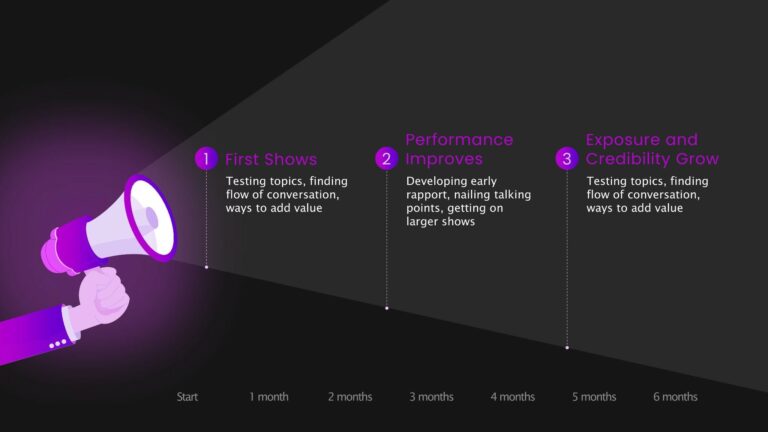
Laddering prioritizes Size of shows and is the best strategy for targeting the largest audiences. Because of its prioritization of Size, it deprioritizes Speed and Topics and prioritizes Volume of shows. The Laddering approach always delivers, but it takes a long time to build up results.
Laddering Program Features:
- Topics = Close Fit to Start, Loose Fit Over Time
- Size = Small to Start, Larger Over Time
- Speed = Slow
- Volume = High
Big Shows Fast
Big Shows Fast is a Campaign approach to getting on big podcasts as quickly as possible. This strategy doesn't work for everyone, as not everyone can get on high listenership/download shows. Established authors and well-known social media influencers, CEOs and entrepreneurs use this strategy to promote launches.
Pitches must be highly customized, and guests often have something (besides their own launch) that's timely or newsworthy to talk about.
This approach is time-efficient to reach very large audiences and generally has the highest ROI for a launch. The trade-off for time can be costly, as some large shows charge money for sponsored appearances, usually in the thousands or tens of thousands of dollars.
Big Shows Fast Campaign Features:
- Topics = Loose Fit
- Size = Large
- Speed = Fast
- Volume = Low-Medium
Niche-Targeted
Niche-Targeted is a Campaign approach to appear on highly industry-specific podcasts. These Campaigns are B2B plays to build know-like-trust in a specific industry, generally in a short amount of time, often with less than 50 shows.
The priority with a Niche-Targeted approach is to book shows that cover niche topics (i.e. AI, People Success/HR, etc). This approach can be used quickly and inexpensively for product launches and personal branding efforts in niche industries.
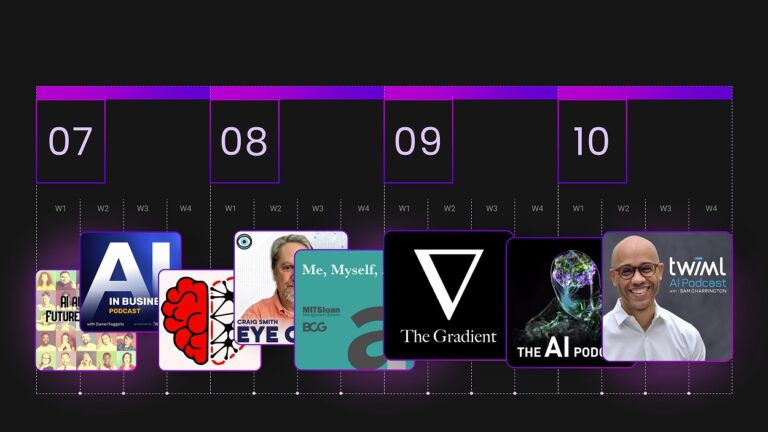
Niche-Targeted Campaign Features:
- Topics = Close Fit
- Size = Small
- Speed = Slow-Fast
- Volume = Low
Building Your Podcast List
Finding the right shows to appear on is the most important element to your success in appearing on podcasts.
If you don't find shows that are a good fit for your Goals and Strategy, it won't matter how well you execute the rest of your booking effort. If you choose shows that you don't have a chance of appearing on, you won’t get booked at all. If you choose shows that are too small, you will spend a lot of time in interviews but you won't reach the size of audience you need to reach. If you choose shows that are a niche mismatch - you will not achieve the results you want. If you choose shows that don't hold quality interviews, you will waste your time. If you choose shows with formats that aren't focused on interviews, you will get a lot of "no's". If you don't find enough shows, you won't reach the amount of people you need to achieve your goals.
Your guesting list should be larger than you might imagine, as you should expect to get on ~ 1/3 of the shows you reach out to. If you're managing a low-volume podcast tour, you might identify 30-50 podcasts. If you're running a Laddering approach, you may want to build a list as large as 100 or 200 shows.
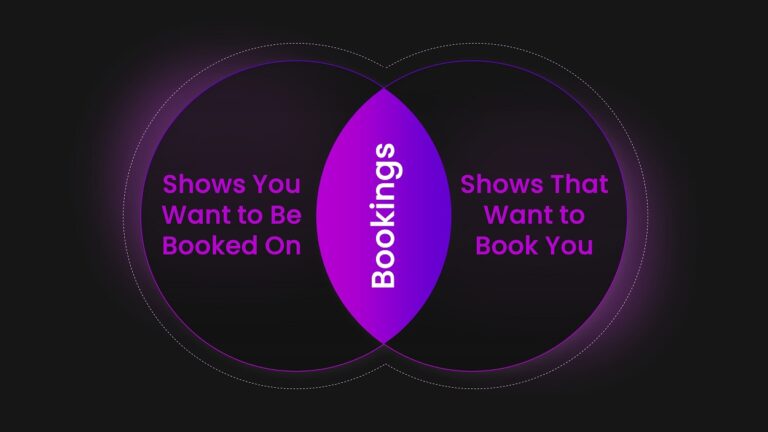
Creating a Tracking List
We recommend a spreadsheet or simple database (i.e. Notion), with show details and tracking information, like below, to track the shows you want to appear on.
As you find shows that meet your needs, add them to this tracking sheet.
- Name
- Website
- Host Name
- Primary Contact
- Secondary Contact
- Topic/Focus
- Episode Takeaway
- Pitch #1
- Pitch #2
- Application
- Y/N
- Date Scheduled
- Appeared - checkbox
- Release Date
- Comments
Finding Podcasts
Asking Your Social Followers
What podcasts does your current audience listen to? Ask your social followers via Instagram, Twitter and LinkedIn and see what responses you get. Send a survey to your email list - we love a good Typeform survey.
Researching Influential Competitors
A simple Google search for "[name of influencer]" + "podcast" will deliver phrase matched searches for the name of the person and the word "podcast" to find you links to shows.
"Dan Martell" "Podcast"
Instead of digging through thousands of listings, you can narrow your search to shows that are more likely to be active or highly relevant by filtering for shows published in the last year using Tools -> Past year.
Google results will pull in videos, website links, directories and some database results. You can further refine your list by adding a "site" search filter for a directory, like Apple Podcasts by adding site: podcasts.apple.com
"Dan Martell" "Podcast" site:podcasts.apple.com
Add shows to your list as you search and don't worry too much about analyzing the shows to see if they're a good fit (we'll do that later).
Niche Topic + Podcast Google Search
Define the niche searches in your industry and then try Googling “[Niche Topic]" "Podcast” to see what results you get. A broad topic will return hundreds of thousands of searches, but a more narrow search will deliver highly-specific results, and likely a lot of highly relevant niche podcasts to add to your list.
If you’re struggling to identify niche searches, take a look at the keyword targeting in your Google Ads account or your SEO keyword lists.
“[Niche Topic]" "Podcast”
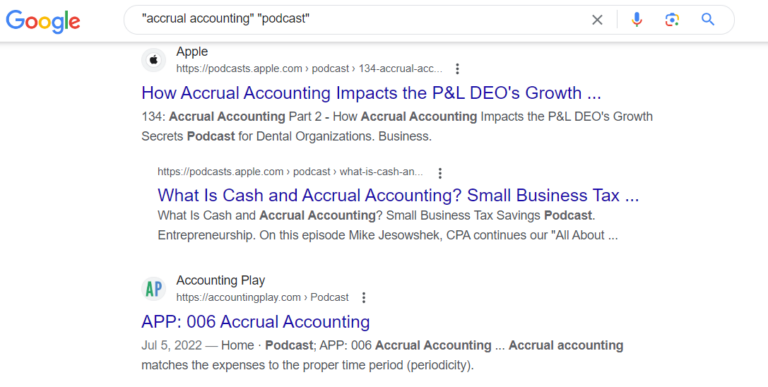
Searching Quora & Reddit Threads
Try keyword searches on Google, but refine your results to only Quora and Reddit results. You'll need to first narrow down what kinds of topics are relevant to you.
"[topic]" "podcast" site:reddit.com
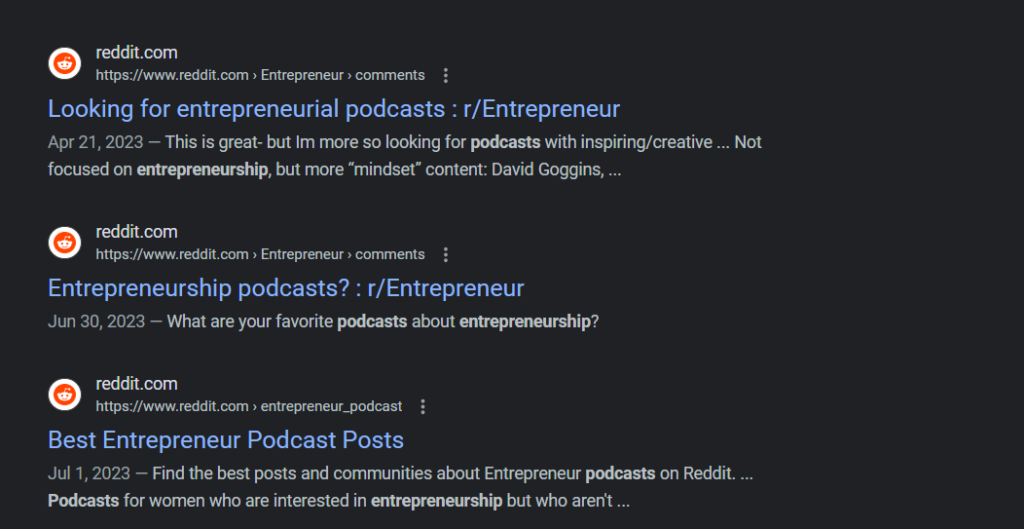
Search Sparktoro's Podcasts
Sparktoro's Audience Research tool allows you to search for podcasts that people who talk about your Topic engage with. It's the most complete audience-focused research tool specific to podcasts.
Filter your results by Last Episode Date to ensure your search returns only active podcasts.
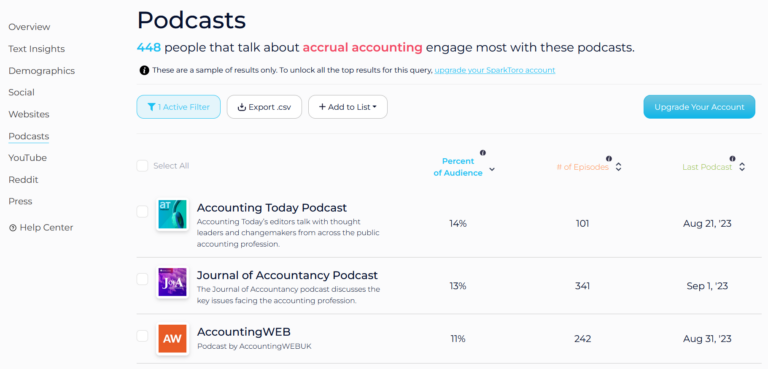
Search Buzzsumo Influencers
Buzzsumo is a remarkable multi-purpose content tool that can help you find shows through its Influencer search feature. Most big shows have a Twitter handle and these days most podcasts publish to a YouTube channel. Buzzsumo’s Twitter and YouTube search tools will pull different results, so be sure to search both.
If you're on a paid plan, you can Export your search results and comb through a spreadsheet instead of navigating through pages of results.
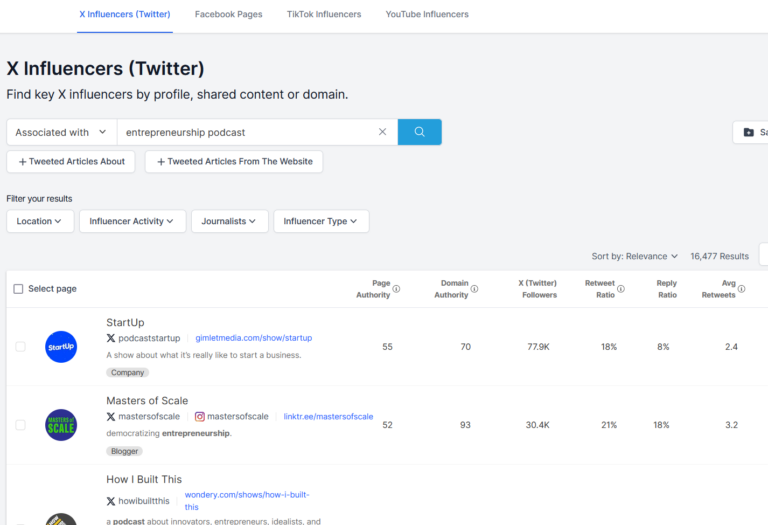
Scanning Podcast Directories
Podcast directories are a critical tool for finding details about shows, and you'll need to use them to analyze your list (we’ll cover this later), but they’re also a good source for podcast discovery. There are a slew of directories, but Apple Podcasts is the largest and most complete directory. Google Podcasts is great, too, and it allows you to search for individual episodes, which is helpful in finding Topic fit.
Start your search, in say, Apple Podcasts, by finding a show you’re interested in, then scroll to the bottom of the page to "You Might Also Like" and click "See All" to see a list of 30 related podcasts.
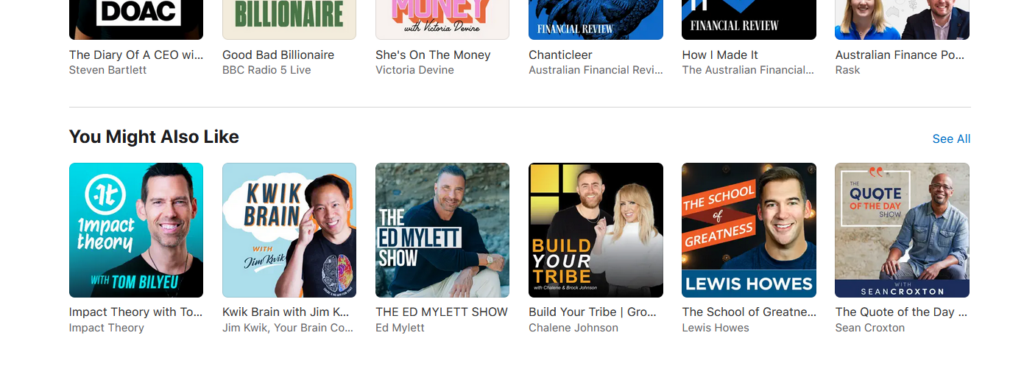
As you click into additional shows of interest, you'll find more related shows. This might be enough to build an initial small list of relevant shows for a Campaign.
Searching Podcast Databases
Podcast-specific databases are the most efficient tools for finding shows. Listen Notes is the largest podcast database. PodChaser is a smaller database. Podseeker has a more focused search function. Rephonic has helpful filters that the others do not. We recommend not relying on any one database to find shows, but if we had to pick two, we'd choose Listen Notes and Rephonic.
Use Listen Notes' search function with "quotes" around your keywords to refine your search, then Filter to narrow by your Category, Language, and Region. Add filters for podcasts with at least 10-20 episodes, for shows that have an Average audio length of 30 minutes, and a publish date within the last month or two.
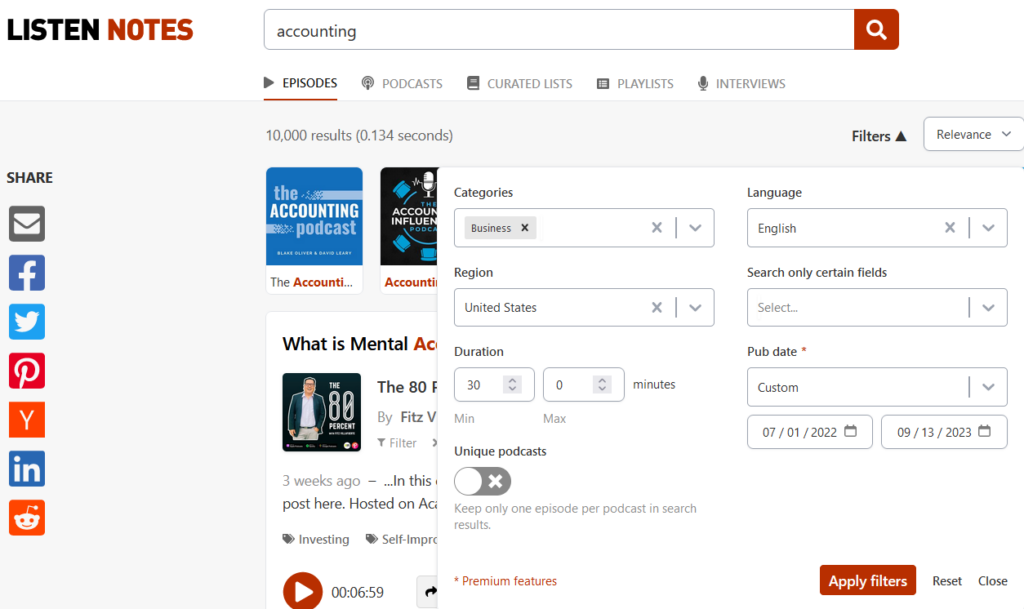
Export the list of podcasts to comb through a spreadsheet and assess shows in the list with an expanded list of statistics to filter from.
The critical part of assessing hundreds or thousands of shows is filtering out shows that are outside the top 5% of Global Rank.
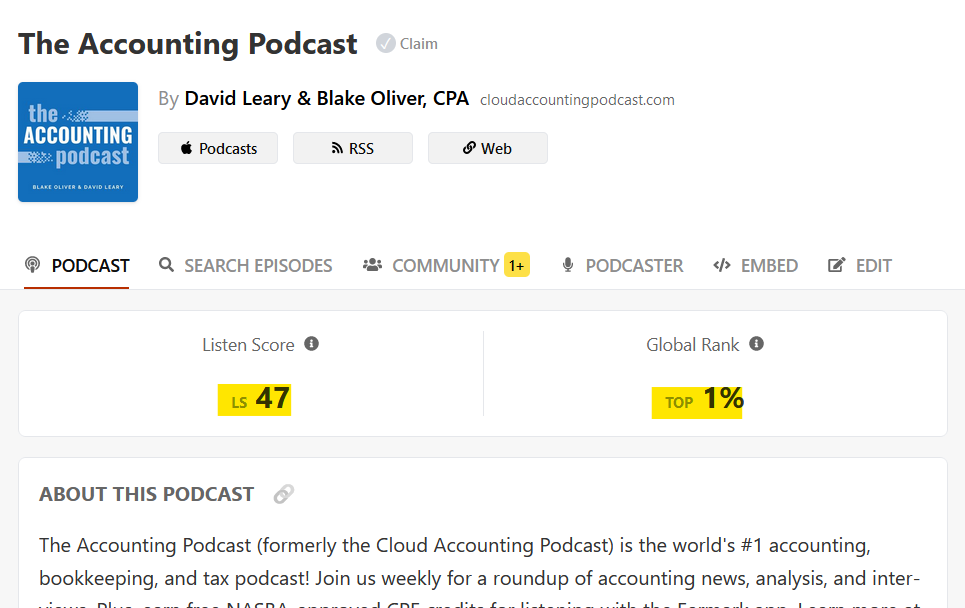
The average episode downloads for the top 1% of podcasts is 5,102 and the top 5% is 1,129, according to Buzzsprout's global stats. Getting on podcasts in the bottom 95% is often not a good use of your time unless they’re niche-specific.
Find Contact Information for each podcast in Listen Notes and save that info to your spreadsheet.
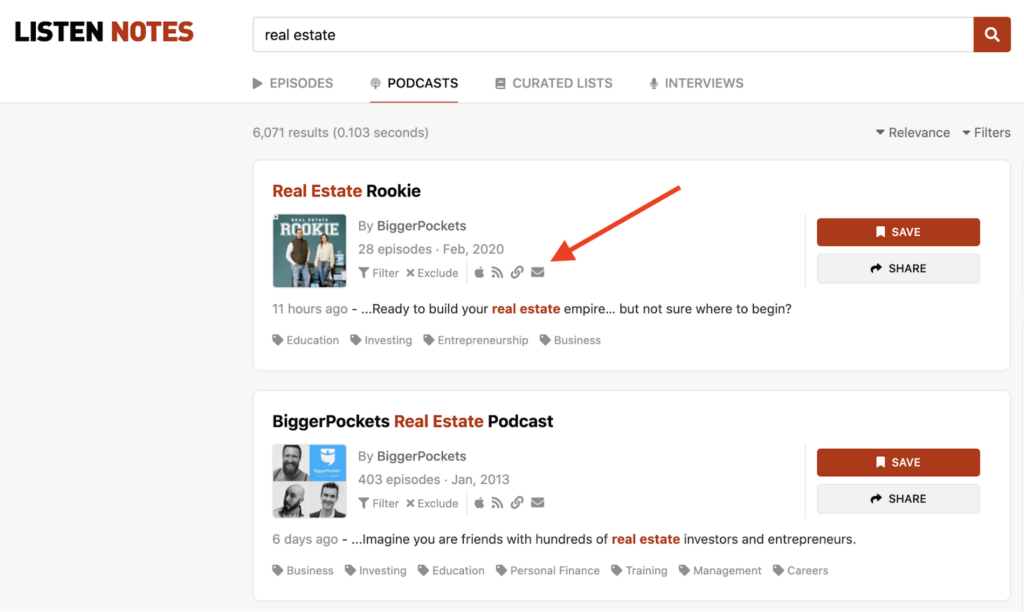
In Rephonic, use their search feature to search for Podcasts by Topic. Consider applying a Category on top of that search. Use quotation marks around the search to refine your results.
Filters is where your search Click on the Listeners filter and filter out shows under 1,000 listeners per episode, at least. Choose your Language, Audience Location, interview Format, desired Social Reach and publishing frequency.
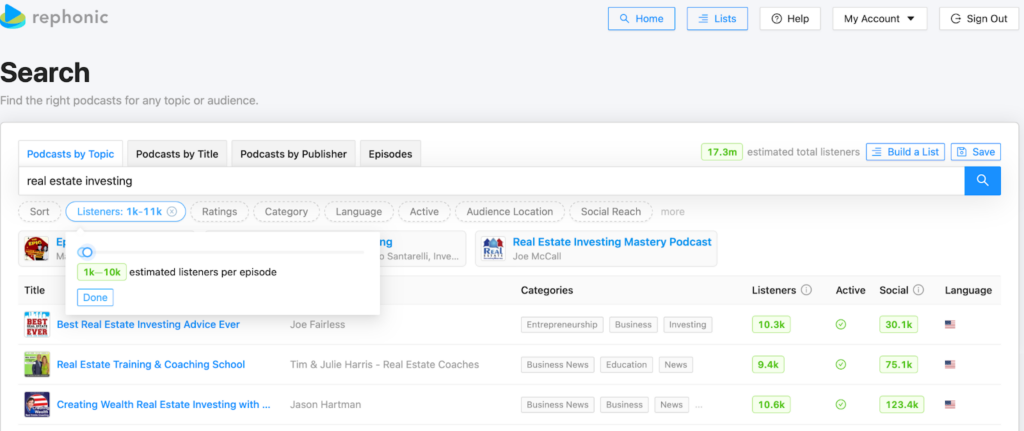
- Listeners - at least 1,000 listeners per episode, likely more
- Language - your language
- Audience Location - your audience's location
- Social Reach
- Format - Guests or Interviews
- Publishes - Weekly, Twice Weekly, Monthly
To build an exportable list that includes contact information, click “Add” to add individual shows to a new list.
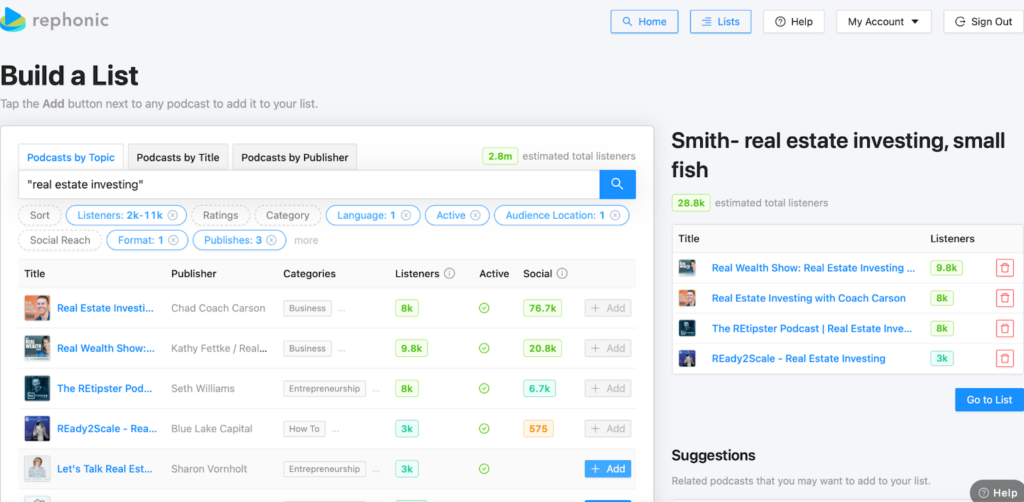
A list export pulls in contact information into columns of a spreadsheet - add that contact info to your tracking sheet.
Rephonic also offers a "concierge" option where their team will help you hunt down email addresses for the shows you want to get booked on.
Podcast Matching Services
There are also matchmaking databases including MatchMaker, PodMatch, and our own, Guestio. Most of these services are free to join and there's little risk in exploring the podcasts in these databases to see which are open to interview guests.
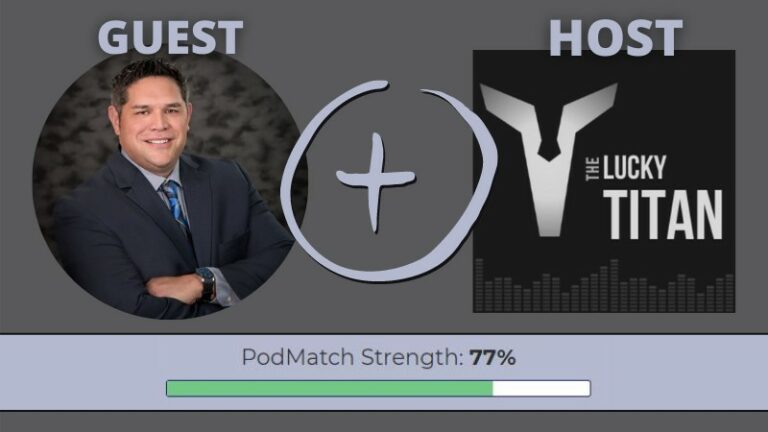
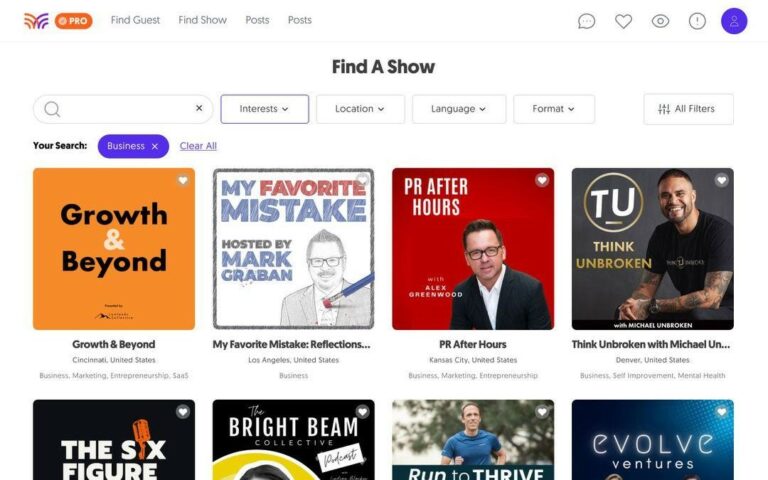
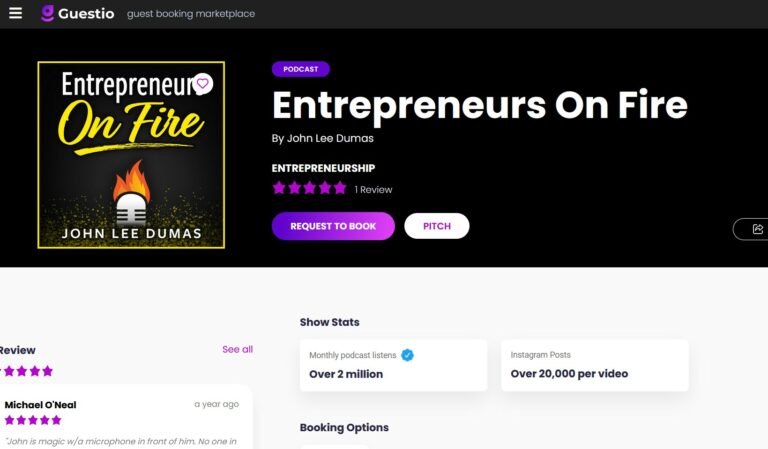
Analyzing Your List
With a big list of shows in your tracking sheet, you’ll want to assess each show to determine whether it’s a good fit or not. This section will guide you through a few basic criteria to trim down your list. After that basic criteria, we’ll show you how to find two types of fit: Audience fit, and Topic Fit.
On Audience Fit & Topic Fit
Audience fit is simply about reaching the right people. Topic fit is about the topics that the show covers. A given show can be a great audience fit but not a topical fit, and vice-versa. For example, if you're a growth marketer who wants to reach 30-40 year-old small business entrepreneurs, your task is to find shows that match both the topic and the audience. If a given show covers finance for entrepreneurs, you won't be a good fit for that show. If the show covers growth marketing for venture-backed startups, then you won't reach SMB entrepreneurs. To flesh out the example:
- Audience Fit, No Topic fit
- Mastering Your Small Business Finances ~ Money Management, Bookkeeping, Entrepreneurship, Side Hustle, Accounting, Cash Flow is for entrepreneurs, so there’s Audience fit, but it only covers finance, and therefore has no Topic fit.
- How I Built This with Guy Raz has Audience fit, as it’s people talking about how they grew companies, but it may not have Topic fit, as the topic of the show covers personal stories about how an individual built a large company. There’s nuance here!
- Topic Fit, No Audience Fit
- a16z Podcast covers startup growth, which is a Topic fit, but it covers growth for a venture capital, high-growth company perspective, NOT a small business/founder/entrepreneur perspective, so it’s likely to draw tech executives and VCs instead of 30-40 year old entrepreneurs
- Lenny's Podcast is another podcast that covers growth, but it interviews tech executives at larger companies and likely will draw an Audience similar to its guests.
- Good Fits
- High Growth Founders is both an Audience Fit and a Topic Fit. It’s targeting Founders, which means it’s for smaller startups, which are more likely to reach 30-40 year entrepreneurs who are struggling to grow their businesses. It’s covering growth topics, too!
- The Nathan Barry Show is an Audience Fit because it targets creators & small business entrepreneurs who are trying to “build a profitable online business.” It’s a Topic Fit because it discusses marketing, launching products and the common issues with scaling small businesses.
Basic Criteria
Trim your list based on the criteria below. Start by opening your favorite podcast directory (i.e. Apple Podcasts) and search for each show on your list.
Overall Topics
Read the Description - does it look like a match for your expertise, the topics you cover, and the audience you're targeting? Titles of shows do not tell you much - some are very vague, and some that seem spot-on may be targeting an audience that is inappropriate for you.
History/Likelihood to Stick Around
Consider cutting shows with less than 50 published episodes. Shows with more than 50 episodes are more likely to stick around and collect listeners over time, delivering incremental listens long after your appearance.
Active
Podcasts come and go frequently and most of the podcasts you’ll find in directories and databases are "inactive" and no longer publishing. Just look at the distribution of active to inactive podcasts by episode count, below. If they haven't published in the last 2 months, you can assume the podcast isn't active and remove it from your list.

https://podcastindustryinsights.com/apple-podcasts-statistics/
(credit: Podcast Industry Insights courtesy of Daniel J. Lewis.)
Interview Format
Does the podcast have an interview format? Some podcasts host interviews irregularly and others change their formats over time. There are two quick filters to determine whether a show is an interview podcast:
- Is the show more than 30 minutes in length? If not, delete it from your list (there are thousands of shows that are between 5-20 min!)
- Do the show titles say "with... [name]" or some other variation? The name of the guest almost always appears in the title of the episode, signaling that it's an interview podcast
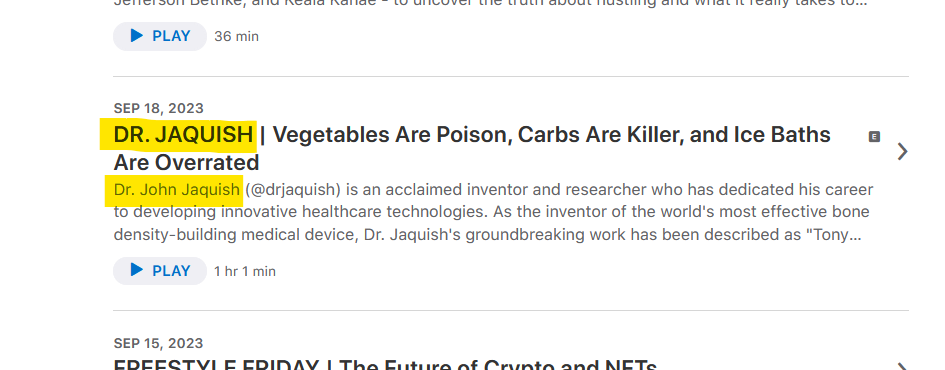
Guest Clout
How authoritative are the past guests they've had on? Do you recognize the names of past guests? Does a quick Google search for a few names reveal large credibility and large social followings? If guests from the past 10 episodes do not ring a bell, you may not be a good fit for the show.
Reviews & Ratings
Does the podcast have at least 20 Reviews? If not, they might not have high enough listenership to be worth an appearance. Is the rating at least 4.0 out of 5? If it's lower than 4.0, that signals a low quality host. Hosts have an outsized impact on the quality of an appearance, so a low quality host with a large audience won't do you any favors.
Note: While this is a helpful filtering step, note that reviews and ratings aren't always trustworthy. Podcasters can buy and exchange reviews and ratings to beef up numbers.
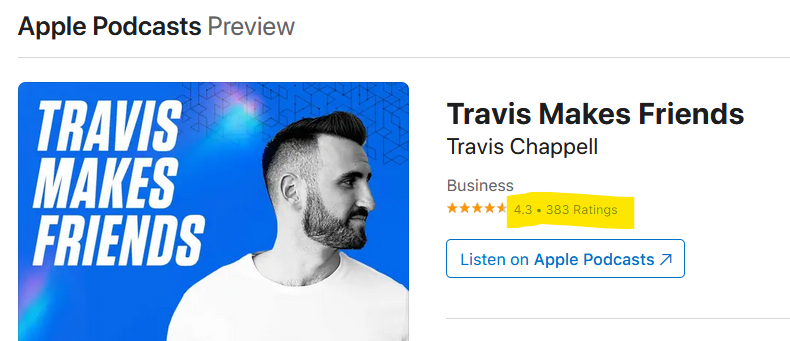
Vibe & Criticism
What is the nature of the Review criticism? What's the nature of the feedback? "Informative" is different from "Funny" than "Inspiring." Does your vibe as a guest match the descriptions you're reading?
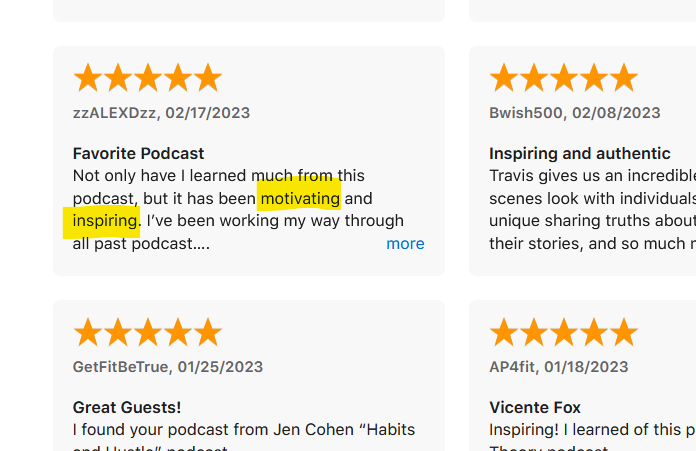
At the end of this review, you should have cut a significant amount of shows from your initial research.
As mentioned previously, you should expect to get booked on about 1/3 of the shows you reach out to, so if at this point your list is 20 shows and you want to appear on 20 shows, go back and build a bigger list.
Refining Your List & Assessing Fit
Assessing fit is critical, and there's no quick way to do it, as you must listen to some of at least one episode to get a sense for the quality of the show and the nature of the audience and topic fit.
The benefit of this work is that it helps you to prepare a personalized Pitch for each show you end up reaching out to.
Listen to An Episode Intro
Choose an episode of a guest you're interested in, or ideally, one that covers topics close to your own topics (this will help with your Pitches). Listen at 2X speed to move quickly through your list. Pay special attention to the beginning of the episode:
- Intro Production - Listen to the show introduction. If the production is very low quality or if there's no introduction at all, it's likely a show with a low budget and lack of listeners and followers
- Guest Introduction - How does the host introduce their guests? Does the host open by asking the guest "tell us about yourself?"- that's a sign of a weak interviewer, and a weak interview will not help you reach your goals, no matter how many people are listening
Find a Key Takeaway
As you listen to shows in your list and delete shows that aren’t good fits, continue listening into the meat of the interview to hear what the guest has to say. Find a Key Takeaway from the episode and write it into the "Episode Takeaway" column in your Spreadsheet.
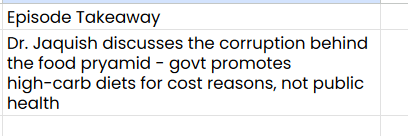
This Takeaway will help you personalize your Pitch to the show, showing the host that you’ve done your homework and are taking your outreach seriously.
Social Content Quality & Follower Count
Look at the hosts' social profiles - do they post high-quality content? Follower counts matter, as they signal the size of the audience you may be able to reach via an appearance, but pay special attention to engagement. Anyone can buy social followers, but it's a lot harder to fake engagement.
This can be time-consuming, but this research can pull double-duty, as if you get a "yes" you already know a little about the host and can cross off some pre-show prep work.
Creating a Media Kit
Your media kit is your positioning as a guest. While your Pitch is a "foot in the door," the Media Kit is the layer of disclosure about who you are and the value you can bring to a podcaster's audience. While a Pitch is brief and text-based, the Media Kit is your chance to show yourself and your personality. Think, a resume, with personality.
In crowded industries like consulting and coaching, showing yourself to be different from the competition can be the difference between a booking and a rejection.
How to Approach The Media Kit
Your media kit tells podcasters what you stand for. Your best effort plays to your authentic strengths, presents you as credible and professional, and showcases your best work.
The difference between your average influencer or creator media kit and a media kit specific to podcasts is that the influencer kit focuses on social media audience and psychographics while the podcast kit focuses on the value that your voice and presence bring to a long-form podcast. This means the podcast media kit has to present your expertise, your experience, the value your words carry to an audience that is not yours.
Show, Don't Just Tell
Your media kit should be a high-visual asset in the form of a webpage and/or a PDF. We recommend a website so that you can send a mobile-friendly link rather than having a PDF attached to emails. Think short-form - no more than 2 printed pages, including images.
Express Your Personal Brand
Branding matters. High quality logos, visuals, and screenshots create a "feeling." Getting booked on a podcast is ultimately someone's judgment call. Judgment is not a rational decision - it's an emotional one, based on a confluence of factors. Great branding gives you an unquantifiable edge. Branding elements like your personal brand color scheme, font, logo, and overall voice and tone.
Essential Media Kit Elements
Short Bio
Start your media kit with a short bio and a headshot. Don't share your life story - only the parts pertinent to you being a valuable guest to the podcasts you'll be Pitching. Bring all of your copywriting chops to this bio, as you can re-use much of it for your Pitch.
A simple formula for an impactful bio is:
- 1-2 sentences about you
- 1-2 sentences about the company you work for
- 1-2 sentences about the book or event or podcast you're promoting
If you're not promoting a specific book, event or podcast, you might trim back on sentences or carry on longer with an element about you or your company that's relevant to the audiences you seek to get in front of.
Headshot
Include a single headshot to accompany your bio. Choose a photo where you're looking directly at the camera. There's no rule about casualness or seriousness. Find the shot that best represents your professional self and what you stand for.
Here are examples with differing levels of seriousness, professionalism, and personality.


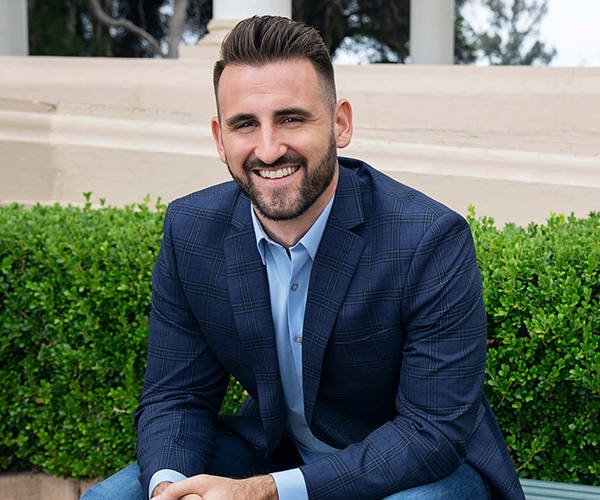
Include multiple headshots in your Kit, but save the extras for the end of your kit. Having a variety of headshots that are genuinely "you" allows a host to choose for the one that best fits their show and audience.
At the end of your kit, feel free to choose shots where you're not looking directly at the camera, as this gives producers creative leeway to design episode assets as they see fit.
Core Topics
Include a bulleted list of 5-7 Topics that you have expertise in and want to talk about. Be specific and descriptive with your words. "Growth marketing" isn't unique or specific - there are thousands of growth marketers and even more who claim to be experts on growth marketing - you will not stand out.
Think "A/B and multivariate testing" and "Designing high-velocity experimentation programs" instead of “growth marketing.”
Links to Past Episodes
Embed YouTube videos of your past podcast appearances or speaking engagements so that hosts can see you in action. Choose the most well-known podcasts or the biggest stages. The bigger the show, the more credibility you represent to potential podcasts. Think of these videos as movie trailers for a potential appearance.
If you don't have video to show, link to audio files. If you don't have audio, skip this section and double down on Awards and Recognition.
Awards and Recognition
Awards and recognition is about social proof. You've shared your background and shared your expertise - now you need 3rd-party validation. What awards have you won? What awards have your company won? What other 3rd party validation can you show? Ratings and reviews?
Remember, you want to show as much as possible - don’t say “award-winning” - use screenshots and include links to your awards.

Press Coverage
Add any press coverage in the form of links and articles. Include press releases if that's all you've got. This helps expand your credibility through 3rd-party validation.
Social Follower Counts (+Engagement)
Social follower counts serve as social proof but also show that you have a built-in audience - an audience you can promote the podcaster’s episode to expand their reach. Many podcast hosts will go looking for this data anyway, so you might as well share in the media kit.
Always round your numbers to the nearest thousandth (37,000 followers vs. 37,321 followers).

Fake followers is a real problem in the podcast world. Include engagement metrics if they help you make your case.
Contact Info
Include links to your social profiles and include your Email Address and any other contact information that is relevant for podcast hosts. Make yourself easy to find.
Other Elements That Can Help
- Podcast downloads, revenue of your company or any other highly impactful statistics to share
- Your personal mission or purpose - We're attracted to people who have clarity about what they're trying to achieve and are transparent about it. Being clear about your mission removes guesswork about your motives.
- Frameworks, words, phrases or acronyms you've coined - This communicates thought leadership and credibility in your industry.
- Target audience - Who's your buyer or your target audience you're trying to reach? This can help hosts see a match. Basic demographic (i.e. ages, location(s)) and psychographics (i.e. interests) of your audience is plenty.
- Testimonials - Testimonials about yourself, your service or your product can be helpful, but be careful of including information that isn't directly about you.
Media Kit Tools & Templates
You don't have to build your media kit entirely from scratch. There are several tools out there that do a great job, some are free, some are paid. Canva has pre-built templates that allows you to drag-and-drop text and images and produce a clean visual. Etsy also has digital media kit templates for download if you search "content creator media kit" "influencer media kit." Mediakits is used by many podcasters and podcast guests.
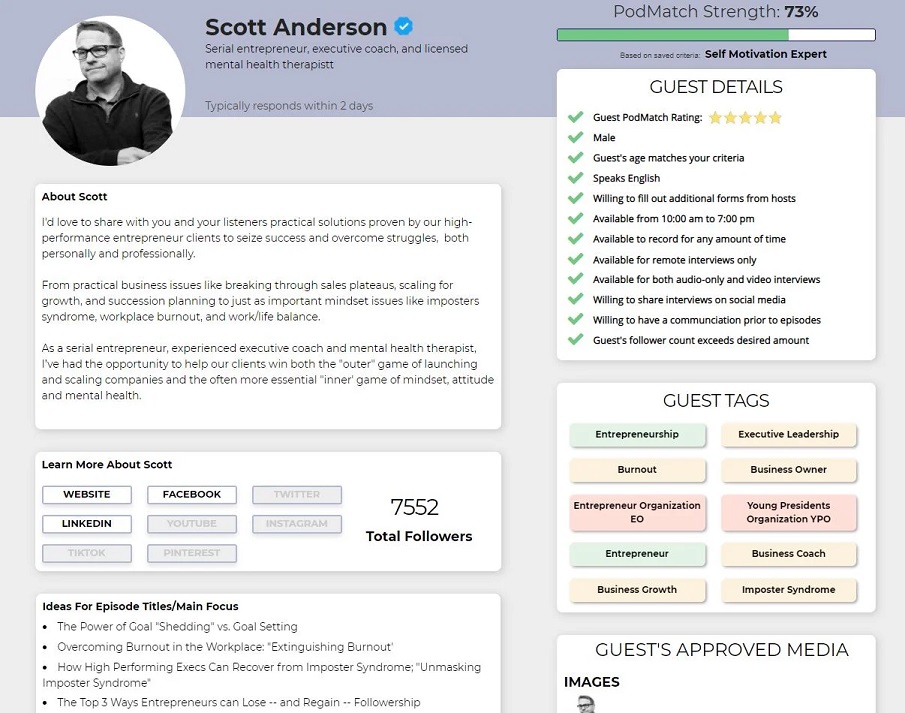
An example PodMatch Media Kit
Lastly, remember to update your media kit throughout your guesting effort. As you stack up appearances and gain traction, you want to make sure your numbers are up to date and you're representing yourself at your best.
Finding Contact Information
If you can't reach the person who books guests for a given podcast, you won't have a chance to get booked. Finding the correct contact information is a critically important step in the booking process.
Hosts, Gatekeepers & Publishers
Hosts May Not Book Their Own Guests
For small podcasts, the host often does their own booking via email. Some podcasters have Linktree accounts with their email addresses listed, and some B2B podcasters have their email address listed on their LinkedIn profile.
Some hosts will respond to direct messages on social platforms.
Gatekeepers & Applications
Larger shows tend to use applications and/or have a person dedicated to filtering incoming email and booking guests. If you can’t find an application for a given show, send your Pitch via email - they’ll often reply with an application link.

Ultimate decisions come down to the podcast host, but to get to a host for a big show, you often have to get through that gatekeeper.
Publishers Are a No-Go
Emailing with podcast publishers is a nice idea that rarely pays off. Publishers may have some influence, but podcasts typically operate independently with hosts making programming and guest booking decisions.
Find Their Website & Media Kit
Start your search by finding their podcast website and looking for their media kit. You'll likely find an email address, usually a generic one, but one that should get an email to an inbox that gets checked by someone.
On media kits and websites you might find an application URL. You’re better off filling out an application and then following up via email or a social DM than blasting "info@" email addresses and hoping for the best.
You can also try a "Contact" page or section on their personal website and look for email addresses of an assistant or booking manager.
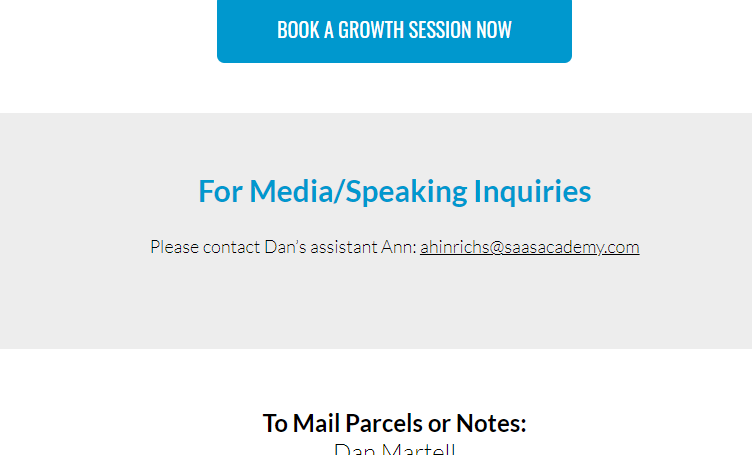
Try a Search With Operators
A good ol' Google search can lead you to the shows website or other websites and directories that list email addresses. Try these searches:
- [Podcast Host Name] + email (or) email address
- [Podcast Host Name] + contact (or) contact information (or) contact me
- [Podcast Show Name] + email (or) email address
- [Podcast Show Name] + contact (or) contact information (or) contact me
Use Email Finding Tools
Using email finding tools is a highly efficient tactic for finding a lot of email addresses. There are many guides to using these tools - see Ahrefs' guide, Hunter.io's guide and Yesware's guide.
A few of our favorite tools are Hunter.io, Voila Norbert. A quick, free option that can work is the Clearbit Connect browser extension.
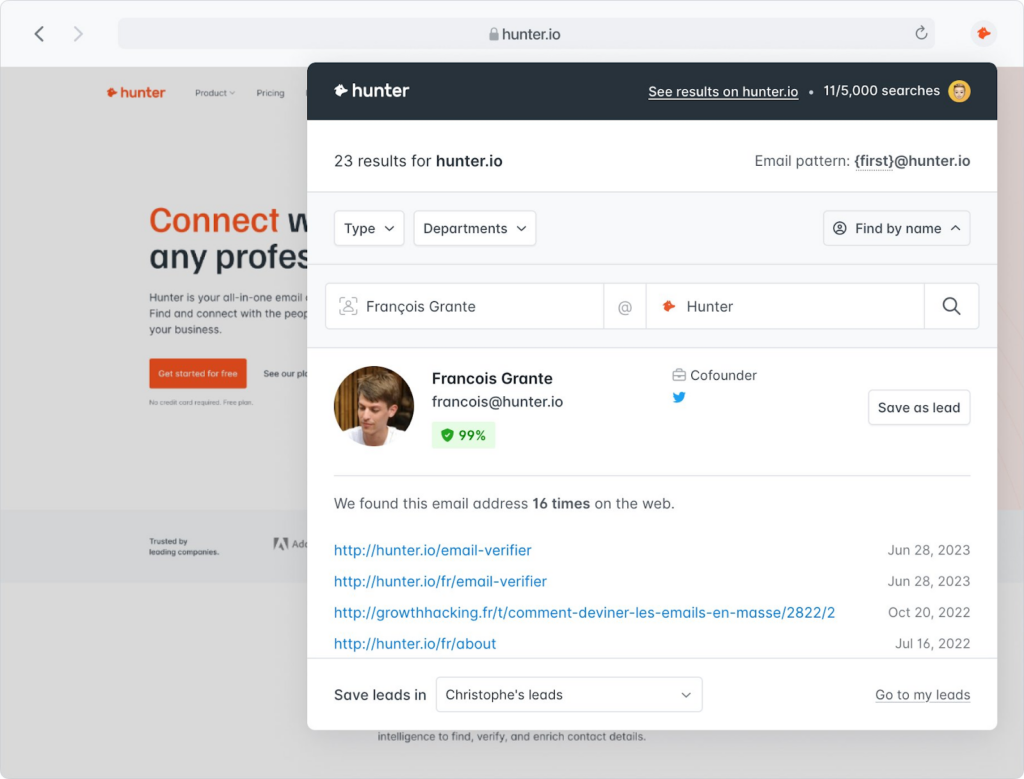
Planning Your Pitch
Assuming you have the right contact information, you have two hurdles to overcome in your Pitch. The first is skepticism from the recipient in whether your email is legitimate - Is it pure spam or a shotgunned email blast? Is this person real? The second is whether you might be a good fit for their podcast.
The first hurdle is overcome by using a great structure and abiding by some key principles. The second comes down to the art of positioning and selling yourself.
On Cold Outreach In Podcasting
Most Interview Podcasters Welcome Pitches
Pitching can be perceived as "icky" - we've all been on the receiving end of bad cold outreach. The difference with interview podcasts is that they constantly need new guests and new guest ideas. But make no mistake - podcasters these days get a TON of Pitches. What podcasters don't want is bad Pitches.
Great Pitches are based on a few key principles, and a few necessary elements. We'll cover them in detail in this section.
Big Shows Book In Advance
Most podcasters like to have a well-planned content calendar and schedule. You're unlikely to reach out to an established, high-listenership podcast and get booked next week. Appearances are likely to take weeks, and sometimes months.
Biggest Shows Book Proactively
The biggest shows have lists of guests they want to have on and will go after those guests. They'll most likely turn down any Pitch attempts. Your best bet to get on the biggest podcasts is to be someone who's already on their radar.
Pitch Elements
Fill out each of the variables below to write your Pitch. You may not use all of them in your Pitch, but having elements to play with allows you to build your best possible Pitch and Follow-Ups.
You can reuse a lot of the work you've done in your Media Kit!
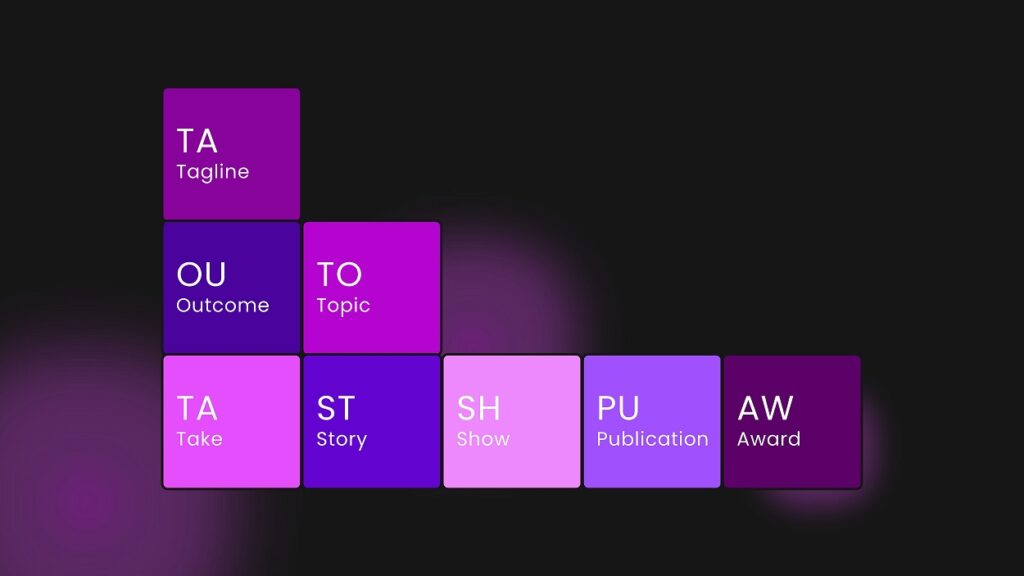
Tagline
Do you have a personal tagline? A tagline is a short, catchy statement that summarizes who you are and what value you bring to podcasts.
Example: “Serial entrepreneur with 8 exits”
Outcome
The outcome is a declarative statement about what you or business produces for your audience and customers.
Examples:
- Making B2B Content Measurable
- Teaching Marketers How to Leverage In-House Talent to Market The Brand
- Driving Greater Content Performance From Less Resources
Topic
A topic is an area of subject matter within an industry. A subtopic is a smaller, more concrete topic within a larger topic (defining subtopics isn’t so important, except as a way of thinking about Takes, covered below). Try to come up with a balance of both.
Example:
- Topic: Content Marketing
- Subtopics: Content Calendars, Content Ideation, Content Distribution
Take
A take is a unique perspective on a Topic or subtopic. Create your takes with a few questions:
- Ongoing effort to appear on shows
- ~ Weekly podcast appearances
- Grows reach and brand affinity
Examples:
- Books Are Still an Underrated Marketing Channel
- TikTok Is the Best Opportunity in B2B Content Distribution
- Content Calendars Are Outdated in 2023
Story
A story can be a quick anecdote or a long-form origin story. The story can be a personal story or a company story. The more stories, the better, as you don't want to Pitch the same stories to every podcast and you don't want to be one of those guests who tell the same story across a slew of podcasts.
Examples:
- A childhood spent delivering newspapers developed an early work ethic
- We started with repurposed doors as desks, and that ethos of frugality lives on
Show
A list of shows you have appeared on. Prioritize the most well-known shows with the most recognizable host names. Podcasts are best, but YouTube interviews and other show links work, too.
Publication/Award
A list of publications you or your company have appeared on. Prioritize the most well-known, and include links.
Build a list of awards you have won or been nominated for in the recent past, ideally strongly related to your angle for your Pitch.
Pitch Anatomy
Every email Pitch has eight common components. These components utilize the Pitch Elements you’ve created.
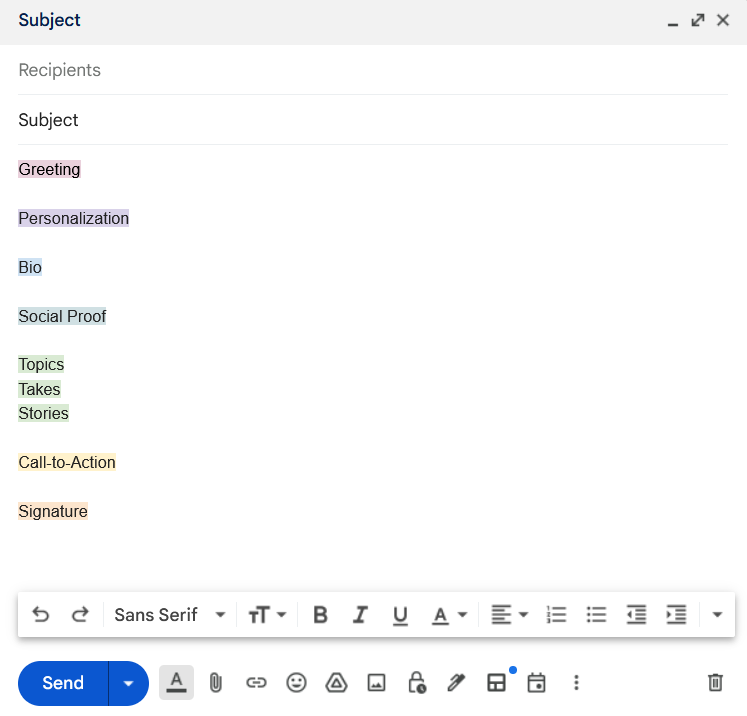
Subject Line
Every Pitch has a subject line, and subject lines are critically important for generating opens. If your message doesn’t get open, it won’t get read.
Make entirely clear that you're reaching out about appearing as a guest. You have limited characters to do that. Optimize for clarity - don't tease or try to optimize for opens. Make the subject line clear as to what you're asking about.
Make it explicitly clear that you're making a "Podcast Guest" Pitch. If hosts and their teams are getting thousands of "shot in the dark" sales outreach emails and dozens of Podcast Pitches, you want to make sure you're being sorted into a Podcast Pitch folder/inbox.
Examples:
- Podcast Guest Pitch: [Topic]
- Podcast Guest Pitch: [Take]
- Podcast Guest Pitch: [Outcome]
- Guest Pitch: [Topic]
- Guest Pitch: [Take]
- Guest Pitch: [Outcome]
Greeting
Approach like a friend. You may not be their friend, but be friendly. Never start with "To whom it may concern," "Sir" or "Dear." Don't "hope the email finds them well."
Examples:
- Hi [Host/Producer], I’m [your name] with [your company]
Personalization
Personalize at least the first 1-2 lines of your message for that specific Host. Prove that you know of the podcast and the host’s content. Explain why their content is meaningful to you.
How do you know them? What do you know about them? What do you like about their podcast or their last episode? How are you going to implement the lesson? When? What change has it created in you? i.e. "never thought of it that way" "changed my thinking about..." Did you share it with someone?
Hone in on a specific Topic and have a specific Take you can share. Tailor your expertise to the niche topics that the podcast addresses.
Emojis, abbreviations, humor, slang can all work in a casual, friendly approach, but don’t come off like a direct response copywriter or a spammer - avoid excessive emboldening, underlining, italics & emojis. Robots and spammers talk like this:
- I just read your article and it is very cool.
- I’m a long-time reader of your blog and I think your content is totally amazing.
- Thanks for posting your outstanding article about %topic%, I’ve learned a lot from it.
Don't deceive. Don’t manipulate people. If you don't believe it, don't say it. If you don’t like their podcast, don’t say you like their podcast.
Examples:
- I listened to your episode with [guest] and [your emotion/takeaway/thought] on the topic of [Topic]. My perspective is different than theirs, as I believe [Take]
- I know you cover [Topic] at a deep level, and I think I could bring some expertise to your audience, especially with regard to [Topic], [Topic], and [Topic].
Bio
Introduce yourself. Who are you? If you've never emailed them before, introduce yourself. Don't tell them your life story - what's your name, and what's your job title or a two-word description?
Your Bio can be taken directly or repurposed from your Media Kit. Aim for no more than 2 lines for your email Bio.
Examples:
- I'm [your name] the [job title] of [your company], and we [Outcome]. My personal brand is positioned at the intersection of [Topic], [Topic], and [Topic]. I champion [Take] and [Take]. Here’s my media kit.
- I'm [your name], the founder of [your company], a company that focuses on [Outcome]. [Take]. Here’s my media kit.
Social Proof
Social proof is critical for proving credibility. This is where you include Awards, Publications and Podcasts you’ve been on. You can include social proof throughout your Pitch, but try to include it early, ideally after your Bio. Even if a host has never heard of you, if you’ve been on a show they know, you have instant credibility.
Prove your value by sending them a link to a past episode. Choose the one with the biggest podcast you've been on.
Examples:
- I/[your company] was a finalist for [Award], and have been covered by the [Publication], [Publication], [Publication]. You can hear me discuss [Topic] here (video link). I’ve recently appeared on [Show] and [Show] (here, and here).
- I’ve been published on [Publication], [Publication], [Publication], and have made recent appearances on [Show] and [Show]. To hear me in action, here’s a link to my appearance on [Show]
Topics, Takes, or Stories
The more ideas and angles you have, the better, and that’s where your Pitch Element work can shine.
Do you have a step-by-step, a framework and/or some actionable takeaways that you can share? Offering actionable value or a straightforward explanation ensures that whether or not a free-flowing conversation and strong chemistry leads to interesting areas or not, the audience will come away with something valuable.
Include Topics and Takes as bulleted lists. Our eyes love to consume lists. Choose your three best topics rather than five good ones.
Examples:
- Here are a few topics that may be relevant to your listeners:
- [Topic]
- [Topic]
- [Topic]
- Here are a few of my takes that could be helpful to your audience:
- [Take]
- [Take]
- [Take]
- Here a two stories that I’d like to share exclusively on your podcast:
- [Story]
- [Story]
Call-to-Action
Your Pitch must make an ask of the Host. Make a single ask, not two. Make your ask straightforward, but try to reduce pressure on an immediate booking. All you want is for a host to consider you. "Any interest?" works just fine.
You can soften your ask by using phrases like "No pressure", "No big deal if not", and "No worries."
Examples:
- "Do you think that would be valuable to your listeners?"
- Do I sound like a good fit for your listeners?
- What do you think? Worth a discussion?
- Any interest?
- What do you think?
Signature
Your signature should be standardized to represent yourself and your organization consistently. Your name, your company, and your role at the company is plenty.
Include an unsubscribe button, if possible. Persistence in following-up is important, but you want to be respectful of people and allow them to opt out.
Plan Your Approach
Where to Send Your Pitch
Email is the standard in podcast Pitching, but reaching out via social works quite well, too. B2B shows might respond better to email or a LinkedIn DM. Others might respond on X (i.e. Twitter), or Instagram.
On social media, where you generally have less visual real estate, you won't want to send a full Pitch, but try to get a foot in the door with a highly personalized message. In some industries, particularly B2B podcasts, a Connection on LinkedIn + a pitch to their DMs can work quite well.
A simple "foot in the door" Pitch on social might look like:
- "I noticed you haven't had a guest on recently to talk about [Topic] and... here's my media kit, what do you think?"
- "I saw you had [Guest Name] on to talk about [Topic]. What they didn't talk about was [Take]/[Talking Point] - I'd love to cover the intricacies of [Topic] from a different angle. Any interest?"
- "I see you had [Guest Name] on - he and I run in similar circles and I think my perspective could be of value to your audience. What do you think?"
Most Pitches are written, but a video proposal can be quite powerful. It’s hard to fake a video Pitch. A video also allows a host to see you “perform” and to see your video/studio setup.
Written messages are easiest to skim, which means you can generally include more words than video. If you're going to send a video, write out your Pitch using the Pitch Elements and Anatomy instead of winging it.
Warming Up Hosts
If you have a dream show on your list, it may be worth playing the long game and "warming up" hosts before reaching out cold via email or social. Start by following the host on social, engaging with their content and adding value in their comments section over a few months.
Three more tactics:
- Leave a review on their Apple Podcasts page and let them know about it
- Send them a copy of your book or a gift from your company
- Promote their show on your social channels and tag them in your post
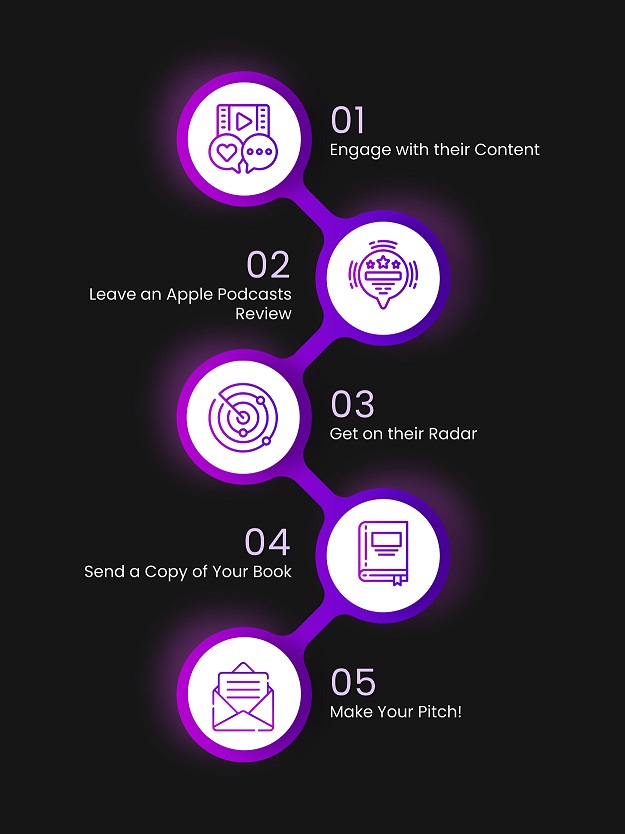
Choosing Your Email Address
What email address will you send from? A company or personal domain address is ideal, and a personal Gmail address works fine. Your old Hotmail email address doesn’t communicate professionalism and won't fly.
Crafting Your Pitch
Clarity over Creativity
Be clear and direct over creative. Lots of sales outreach tries to cut through the noise by being creative and many of these "creative" approaches end up being deceptive. If you optimize for open rate, over time you'll find ways to deceive people into opening.
Create a clear vision for a host. Study their episode titles - what might be the title of their episode with you? What would you cover? Use your [Outcome] line to Pitch them a vision of how you'd be a great fit on their podcast.
Make the Host Feel Special
Make the host feel special - like they're the only show you want to be on. Assume a "yes," and work to prove the assumption.
Don't pitch your brand or your book. You'll have a chance to talk about those things. Think about the value you're going to provide to their audience and the value you'll confer on their show.
Remember, they're getting emailed every day by people who don't know them or their podcast and are mass-emailing shows. Stand out by the care and attention to detail you put into your Pitch.
Sell Yourself
Podcasters are generally looking to:
- Create highly-valuable episodes
- Rub shoulders with influential people
- Grow their audience reach.
The first motive is the most "pure" of all, and the one you should appeal to most directly. What would make your appearance valuable to their specific audience?
The second motive is up to how you position yourself in your Pitch copy and your Media Kit. The third often comes down to their appraisal of your social follower counts and your willingness to promote an episode. You can share your social follower count and email list size if you feel that's relevant, though that might look a little desperate.
As you sell, be careful not to overstate. Don’t puff yourself up as being more than who you are and what you've accomplished. Overstating will be met with suspicion or distrust from the Host - they get these kinds of Pitches all day.
Keep It Short
Get to the point, quickly. Who are you, what are you offering? Assume you have 15 seconds to get a yes/no answer. Bullet-points can be scanned and skimmed quickly - use them!
Cut needless words and aim for 100-200 words total. Think of your pitch as an X Post (i.e. a Tweet) - read it to yourself and strip down words until you’ve hit the word count.
Don’t write more than 2 lines without a link break (on desktop). Walls of text don't get read. One line on desktop is still multiple lines on mobile.
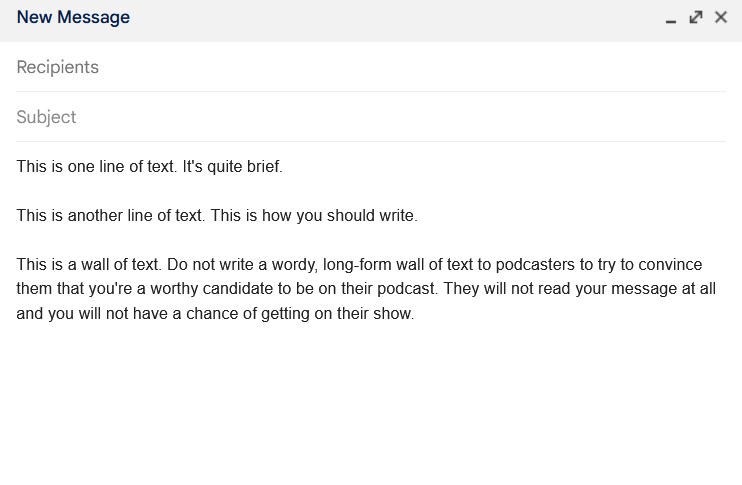
Build Your Template, Then Break It
Templates are helpful for dialing in your language, including key Pitch Elements, and sticking within word counts. Templates are training wheels. Use them to build the structure of your Pitch. Edit the hell out of the template. Then find ways to break the template as you personalize your Pitch for different podcasts.
Following Up
Following up is a contentious topic in the world of Pitches. Always follow-up at least once, preferably a few times. Be patient. Your first Pitch might end up in a folder that gets checked two times per month, so it could take time to get a response, even if that response is a "no".
Never follow up if the recipient explicitly asks you not to or if they say "no." Your email Pitch already meets the definition of spam, so tread carefully with your follow-ups.
How Long to Wait?
Always wait at least two business days between your first Pitch and your first follow-up. Subsequent follow-ups might be spaced apart even further apart - four days, seven days, nine days, for example. If after your last Pitch you haven't heard back, mark them as "not interested" in your spreadsheet.
Sometimes you'll get a response that the recipient will "forward your email along" for a team to consider. Use your best judgment, but don't follow up in 2 days. Give them time and respect in their decision-making as the wheels of their organization turn.
How Many Follow-Ups?
You can be as forward as you see fit - persistence often pays off. There's no limit to how many times you can reach out, and how many channels you can use to secure a Yes or No.
If they don’t respond after your follow-ups, consider telling them you'll stop contacting them - this is good email hygiene, but can sometimes help convert people on the fence.
Track Your Email Opens
If your Pitching and follow-up process takes the better part of a month, it's helpful to know if your emails are actually reaching the intended target (or anyone at all). Getting an "out of office message" is a good sign. Knowing whether you're getting opens at all is another good step.
Track email opens using MixMax to see if the email has been opened. If you are not getting your emails opened, it's possible that you have the wrong contact info. Find a better email, dig deeper to see if there's an application process that bypasses email, or try to pitch via a social channel.
Follow-Up Message Options
When following up, assume the recipient opened the first email. Don’t repeat everything you said in your first email, assume they just didn’t make time to write back.
Feel free to add more value or explanation of why you'd be a great guest. Here are a few options for your Follow-Ups:
- Explain a core Topic in more detail
- Record a video of your Pitch (with language altered)
- Write them a review on Apple Podcasts and let them know
- Share something new you've learned from their recently published podcast or social post
- Offer to promote a potential episode with you and explain how you'd do that. According to a small survey by The Podcast Host, many podcasters struggle most with promoting episodes
- Share your open availability. Lots of busy hosts just aren't sure they can find the time or they can fit you in in a reasonable time window. You may say that you're open to bookings far out in the future, or to accomodate a tight turnaround due to a cancellation or a new opening in their calendar
A message as simple as "Hey! Just bumping this to the top of your inbox. Have you had a chance to think about me as a potential guest?" works just fine, too! Here are a few more:
- Hey, just wanted to check in and see what you thought. Let me know!
- Just reaching out one last time. Let me know what you think!
